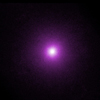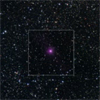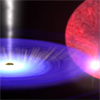CXC Home | Search | Help | Image Use Policy | Latest Images | Privacy | Accessibility | Glossary | Q&A
Tour of GRS 1915+105
Quicktime MPEG
We start with an optical and infrared image that shows the crowded area around the object known as GRS 1915+105, or GRS 1915 for short. Next is a close-up of the Chandra image of GRS 1915, which is located near the plane of the Milky Way. GRS 1915 is a so-called micro-quasar that contains a black hole about fourteen times the mass of the sun, which in turn is pulling material off a nearby companion star. With its high-energy transmission grating, Chandra has observed GRS 1915 eleven times since 1999. These studies reveal that a jet from the black hole in GRS 1915 may be periodically choked off when a hot wind is driven off the disk surrounding the black hole. Conversely, once the wind dies down, the jet can re-emerge. These results suggest that this type of black hole may have a mechanism for regulating the rate at which it grows.
[Runtime: 01:03]
Quicktime MPEG
We start with an optical and infrared image that shows the crowded area around the object known as GRS 1915+105, or GRS 1915 for short. Next is a close-up of the Chandra image of GRS 1915, which is located near the plane of the Milky Way. GRS 1915 is a so-called micro-quasar that contains a black hole about fourteen times the mass of the sun, which in turn is pulling material off a nearby companion star. With its high-energy transmission grating, Chandra has observed GRS 1915 eleven times since 1999. These studies reveal that a jet from the black hole in GRS 1915 may be periodically choked off when a hot wind is driven off the disk surrounding the black hole. Conversely, once the wind dies down, the jet can re-emerge. These results suggest that this type of black hole may have a mechanism for regulating the rate at which it grows.
[Runtime: 01:03]
(Credit: X-ray (NASA/CXC/Harvard/J.Neilsen); Optical & IR (Palomar DSS2))
Images of GRS 1915+105
Quicktime MPEG
Beginning with a wide-field optical image from the Digitized Sky Survey, the view then zooms into Chandra's image of GRS 1915+105. With its spectrograph, Chandra observed this black hole eleven times over the past ten years. This accumulation of data allowed scientists to track the black hole's behavior and determine how it uses different mechanisms - involving a jet and wind - to regulate its growth.
[Runtime: 00:50]
View Stills
Quicktime MPEG
Beginning with a wide-field optical image from the Digitized Sky Survey, the view then zooms into Chandra's image of GRS 1915+105. With its spectrograph, Chandra observed this black hole eleven times over the past ten years. This accumulation of data allowed scientists to track the black hole's behavior and determine how it uses different mechanisms - involving a jet and wind - to regulate its growth.
[Runtime: 00:50]
View Stills
(Credit: X-ray (NASA/CXC/Harvard/J.Neilsen); Optical (Palomar DSS2))
Animation of Jet and Wind around GRS 1915+105
Quicktime MPEG
This animation shows how radio jets may be suppressed in the micro- quasar GRS 1915. Material is being pulled from a red companion star into a black hole via a blue, rapidly rotating disk. The animation begins with a jet blowing material away from the black hole. Later, when the disk is heated by powerful radiation from close to the black hole, a wind is driven off the disk. As the wind strengthens, the jet apparently is shut down because the wind deprives the jet of material that would otherwise have fueled it.
[Runtime: 00:25]
View Stills
Quicktime MPEG
This animation shows how radio jets may be suppressed in the micro- quasar GRS 1915. Material is being pulled from a red companion star into a black hole via a blue, rapidly rotating disk. The animation begins with a jet blowing material away from the black hole. Later, when the disk is heated by powerful radiation from close to the black hole, a wind is driven off the disk. As the wind strengthens, the jet apparently is shut down because the wind deprives the jet of material that would otherwise have fueled it.
[Runtime: 00:25]
View Stills
(Credit: NASA/CXC/A.Hobart)
Return to GRS 1915+105 (March 25, 2009)





